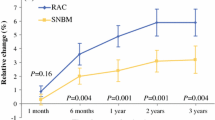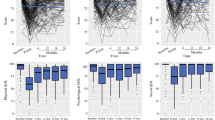Abstract
Background
Postoperative changes after axillary lymph node surgery may significantly alter breast cancer survivors’ (BCS) quality of life. Although sentinel lymph node biopsy (SLNB) has less immediate morbidity than axillary lymph node dissection (ALND), its long-term impact on shoulder abduction, arm swelling, and neurosensory changes has not been evaluated. The purpose of this study was to compare long-term morbidity after SLNB or ALND and breast-conservation surgery.
Methods
Female BCS who remained free of disease at least 3 years after ALND or SLNB for Stage I–III unilateral breast cancer completed a symptom questionnaire and a brief neurosensory physical examination of the upper arm and axilla (range of motion, arm circumference, and sensation to light touch with cotton and needle).
Results
The mean age of the 187 participating BCS was 62 years. At a mean follow-up of 6.6 years after ALND and 4.9 years after SLNB, most BCS had full abduction; only 10 cases (8 ALND, 2 SLNB) had a ≥2 cm proximal and/or distal circumference difference on the ipsilateral side compared with the contralateral side. ALND was associated with a significantly greater likelihood of subjective arm numbness (P < .001), chest or axillary numbness (P < .001), arm or hand swelling (P < .001), and objective neurosensory changes in the posterior axilla, medial and distal upper arm (P < .001). Operative procedure was the only significant predictor of neurosensory changes (P < .001).
Conclusion
SLNB is associated with significantly less subjective and objective long-term morbidity than ALND.

Similar content being viewed by others
References
Erickson VS, Pearson ML, Ganz PA, et al. Arm edema in breast cancer patients. J Natl Cancer Inst 2001; 93:96–111
Ernst MF, Voogd AC, Balder W, et al. Early and late morbidity associated with axillary levels I–III dissection in breast cancer. J Surg Oncol 2002; 79:151–5
Hayes SC, Battistutta D, Parker AW, et al. Assessing task “burden” of daily activities requiring upper body function among women following breast cancer treatment. Support Care Cancer 2005; 13:255–65
Kwan W, Jackson J, Weir LM, et al. Chronic arm morbidity after curative breast cancer treatment: prevalence and impact on quality of life. J Clin Oncol 2002; 20:4242–8
Maunsell E, Brisson J, Deschenes L. Arm problems and psychological distress after surgery for breast cancer. Can J Surg 1993; 36:315–20
Shimozuma K, Ganz PA, Petersen L, et al. Quality of life in the first year after breast cancer surgery: rehabilitation needs and patterns of recovery. Breast Cancer Res Treat 1999; 56:45–57
Ververs JM, Roumen RM, Vingerhoets AJ, et al. Risk, severity and predictors of physical and psychological morbidity after axillary lymph node dissection for breast cancer. Eur J Cancer 2001; 37:991–9
Yap KP, McCready DR, Narod S, et al. Factors influencing arm and axillary symptoms after treatment for node negative breast carcinoma. Cancer 2003; 97:1369–75
Giuliano AE, Kirgan DM, Guenther JM, et al. Lymphatic mapping and sentinel lymphadenectomy for breast cancer. Ann Surg 1994; 220:391–8; discussion 398–401
Baron RH, Fey JV, Borgen PI, et al. Eighteen sensations after breast cancer surgery: a two-year comparison of sentinel lymph node biopsy and axillary lymph node dissection. Oncol Nurs Forum 2004; 31:691–8
Barranger E, Dubernard G, Fleurence J, et al. Subjective morbidity and quality of life after sentinel node biopsy and axillary lymph node dissection for breast cancer. J Surg Oncol 2005; 92:17–22
Blanchard DK, Donohue JH, Reynolds C, et al. Relapse and morbidity in patients undergoing sentinel lymph node biopsy alone or with axillary dissection for breast cancer. Arch Surg 2003; 138:482–7; discussion 487–8
Burak WE, Hollenbeck ST, Zervos EE, et al. Sentinel lymph node biopsy results in less postoperative morbidity compared with axillary lymph node dissection for breast cancer. Am J Surg 2002; 183:23–7
Fleissig A, Fallowfield LJ, Langridge CI, et al. Post-operative arm morbidity and quality of life. Results of the ALMANAC randomised trial comparing sentinel node biopsy with standard axillary treatment in the management of patients with early breast cancer. Breast Cancer Res Treat 2006; 95:279–93
Gill PG, Gebski V, Wetzig N, et al. Sentinel node (SN) based management causes less arm swelling and better quality of life than routine axillary clearance (AC): 1 year outcomes of the SNAC trial. Breast Cancer Res Treat 2006; 100:S14
Golshan M, Martin WJ, Dowlatshahi K. Sentinel lymph node biopsy lowers the rate of lymphedema when compared with standard axillary lymph node dissection. Am Surg 2003; 69:209–11; discussion 212
Haid A, Koberle-Wuhrer R, Knauer M, et al. Morbidity of breast cancer patients following complete axillary dissection or sentinel node biopsy only: a comparative evaluation. Breast Cancer Res Treat 2002; 73:31–6
Haid A, Kuehn T, Konstantiniuk P, et al. Shoulder-arm morbidity following axillary dissection and sentinel node only biopsy for breast cancer. Eur J Surg Oncol 2002; 28:705–10
Langer I, Guller U, Berclaz G, et al. Morbidity of sentinel lymph node biopsy (SLN) alone versus SLN and completion axillary lymph node dissection after breast cancer surgery: a prospective Swiss multicenter study on 659 patients. Ann Surg 2007; 245:452–61
Leidenius M, Leivonen M, Vironen J, et al. The consequences of long-time arm morbidity in node-negative breast cancer patients with sentinel node biopsy or axillary clearance. J Surg Oncol 2005; 92:23–31
Lucci A, McCall LM, Beitsch PD, et al. Surgical complications associated with sentinel lymph node dissection (SLND) plus axillary lymph node dissection compared with SLND alone in the American College of Surgeons Oncology Group Trial Z0011. J Clin Oncol 2007; 25:3657–63
Mansel RE, Fallowfield L, Kissin M, et al. Randomized multicenter trial of sentinel node biopsy versus standard axillary treatment in operable breast cancer: the ALMANAC Trial. J Natl Cancer Inst 2006; 98:599–609
Peintinger F, Reitsamer R, Stranzl H, et al. Comparison of quality of life and arm complaints after axillary lymph node dissection vs sentinel lymph node biopsy in breast cancer patients. Br J Cancer 2003; 89:648–52
Purushotham AD, Upponi S, Klevesath MB, et al. Morbidity after sentinel lymph node biopsy in primary breast cancer: results from a randomized controlled trial. J Clin Oncol 2005; 23:4312–21
Rietman JS, Dijkstra PU, Geertzen JH, et al. Short-term morbidity of the upper limb after sentinel lymph node biopsy or axillary lymph node dissection for stage I or II breast carcinoma. Cancer 2003; 98:690–6
Rietman JS, Dijkstra PU, Geertzen JH, et al. Treatment-related upper limb morbidity 1 year after sentinel lymph node biopsy or axillary lymph node dissection for stage I or II breast cancer. Ann Surg Oncol 2004; 11:1018–24
Rietman JS, Geertzen JH, Hoekstra HJ, et al. Long term treatment related upper limb morbidity and quality of life after sentinel lymph node biopsy for stage I or II breast cancer. Eur J Surg Oncol 2006; 32:148–52
Ronka R, von Smitten K, Tasmuth T, et al. One-year morbidity after sentinel node biopsy and breast surgery. Breast 2005; 14:28–36
Schijven MP, Vingerhoets AJ, Rutten HJ, et al. Comparison of morbidity between axillary lymph node dissection and sentinel node biopsy. Eur J Surg Oncol 2003; 29:341–50
Schrenk P, Rieger R, Shamiyeh A, et al. Morbidity following sentinel lymph node biopsy versus axillary lymph node dissection for patients with breast carcinoma. Cancer 2000; 88:608–14
Swenson KK, Nissen MJ, Ceronsky C, et al. Comparison of side effects between sentinel lymph node and axillary lymph node dissection for breast cancer. Ann Surg Oncol 2002; 9:745–53
Temple LK, Baron R, Cody HS 3rd, et al. Sensory morbidity after sentinel lymph node biopsy and axillary dissection: a prospective study of 233 women. Ann Surg Oncol 2002; 9:654–62
Veronesi U, Paganelli G, Viale G, et al. A randomized comparison of sentinel-node biopsy with routine axillary dissection in breast cancer. N Engl J Med 2003; 349:546–53
Wilke LG, McCall LM, Posther KE, et al. Surgical complications associated with sentinel lymph node biopsy: results from a prospective international cooperative group trial. Ann Surg Oncol 2006; 13:491–500
Baron RH, Fey JV, Borgen PI, et al. Eighteen sensations after breast cancer surgery: a 5-year comparison of sentinel lymph node biopsy and axillary lymph node dissection. Ann Surg Oncol 2007; 14:1653–61
Schulze T, Mucke J, Markwardt J, et al. Long-term morbidity of patients with early breast cancer after sentinel lymph node biopsy compared to axillary lymph node dissection. J Surg Oncol 2006; 93:109–19
Armer JM, Stewart BR. A comparison of four diagnostic criteria for lymphedema in a post-breast cancer population. Lymphat Res Biol 2005; 3:208–17
Paredes JP, Puente JL, Potel J. Variations in sensitivity after sectioning the intercostobrachial nerve. Am J Surg 1990; 160:525–8
Ridner SH, Montgomery LD, Hepworth JT, et al. Comparison of upper limb volume measurement techniques and arm symptoms between healthy volunteers and individuals with known lymphedema. Lymphology 2007; 40:35–46
Smith MJ, Gill PG, Wetzig N, et al. Bs06 patient-rated outcome measures were more sensitive than clinician-rated measures at distinguishing the effects of sentinel node biopsy and axillary clearance in the SNAC trial. ANZ J Surg 2007; 77 Suppl 1:A2
Shamley DR, Srinanaganathan R, Weatherall R, et al. Changes in shoulder muscle size and activity following treatment for breast cancer. Breast Cancer Res Treat 2007; 106:19–27
Wedgwood KR, Benson EA. Non-tumour morbidity and mortality after modified radical mastectomy. Ann R Coll Surg Engl 1992; 74:314–7
Lyman GH, Giuliano AE, Somerfield MR, et al. American Society of Clinical Oncology guideline recommendations for sentinel lymph node biopsy in early-stage breast cancer. J Clin Oncol 2005; 23:7703–20
Albert US, Koller M, Kopp I, et al. Early self-reported impairments in arm functioning of primary breast cancer patients predict late side effects of axillary lymph node dissection: results from a population-based cohort study. Breast Cancer Res Treat 2006; 100:285–92
Acknowledgments
From the Gonda (Goldschmied) Research Laboratories of the John Wayne Cancer Institute at Saint John’s Health Center. Supported by funding from the John Wayne Cancer Institute Auxiliary, the Ben B. and Joyce E. Eisenberg Foundation (Los Angeles, CA), the Fashion Footwear Association of New York Charitable Foundation (New York, NY), and the Associates for Breast and Prostate Cancer Studies (Santa Monica, CA).
Author information
Authors and Affiliations
Corresponding author
Rights and permissions
About this article
Cite this article
Crane-Okada, R., Wascher, R.A., Elashoff, D. et al. Long-Term Morbidity of Sentinel Node Biopsy Versus Complete Axillary Dissection for Unilateral Breast Cancer. Ann Surg Oncol 15, 1996–2005 (2008). https://doi.org/10.1245/s10434-008-9909-y
Received:
Revised:
Accepted:
Published:
Issue Date:
DOI: https://doi.org/10.1245/s10434-008-9909-y




